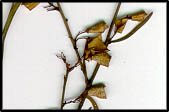South West Slopes Revegetation Guide
Daviesia leptophylla
Slender Bitter-pea
Select from the following for detailed images.
Species Information
| Synonyms |
|
| Common Names |
Slender Bitter-pea |
| Family |
Fabaceae - Pea family. |
| Name Origin |
Daviesia - after botanist the Rev. Hugh Davies (1739-1821). |
Specimen Data - CSU 1510
| Location |
Tarcutta Hill Reserve, NSW. |
| Notes |
Further information see Tarcutta Hill Reserve Flora Survey - Gill Earl. Zone: 55 Easting: 563166 Northing: 6084839 |
| Collector |
Earl, Gill |
Date |
06/05/2000 |
| Determined By |
Earl, Gill |
Date |
06/05/2000 |
South West Slopes Revegetation Guide Information
| Regional: |
Quite widespread in most catchments and districts. Less common in the drier areas to the west. |
| Australia: |
NSW, Vic, SA. |
| Habitat: |
shrubland to dry sclerophyll forest, dry open sites, usually on skeletal soils. |
| Habit: |
broom-like erect shrub to 2 m high, upper branches often 'leafless', with dull yellow-green linear 'leaves' to 6.5 mm long. |
| Similar Species: |
Slender Bitter-pea has narrower 'leaves' and flowers slightly later than Leafy Bitter-pea. |
| Site Preference: |
|
| Characteristics: |
|
| Flowering: |
Yellow and red-brown/orange, Oct-Dec. |
| Seed Collection: |
Early Dec to late Jan. Monitor very closely as seeds released immediately or within 1-2 days of maturity. To ensure collection, cover fruiting branches with nylon stockings or paper bags after flowering. Ripe pods light-brown and brittle and rattle when shaken, with dark-coloured seed. May be difficult to obtain seed in useful quantities. Long storage life. |
| Propagation: |
From scarified seed. Soak in near-boiling water for about 30 seconds, before cooling rapidly under flowing cold water. Alternatively soak in cold water for several hours. Dry to prevent rotting, before sowing. Germination takes |
| Regeneration: |
From seed or suckers, particularly after fire. |
| Timber: |
|
| Shade and Shelter: |
Useful low-level cover in windbreaks. |
| Land Protection: |
Useful understorey in recharge plantings. Legume - improves soil fertility through 'fixing' nitrogen |
| Wildlife: |
Good habitat. Flowers are a pollen and excellent nectar source for various native insects and birds. |
| Ornamental: |
Very decorative. Interesting foliage and attractive perfumed flowers. Plant in clumps to form dense thickets for best effect. Pruning encourages dense growth. |
| Other: |
|
Note: The following information presented is only a guide, as plant characteristics vary depending on provenance (the plant's locality).
| Site/Preferred Habitat : |
well-drained soils |
| Rainfall(mm) : |
500 |
| Growth Rate : |
fast |
| Tolerates : |
frost |
| Resents : |
poor drainage |
| Uses & Comments : |
windbreak; recharge control; fixes nitrogen; wildlife; ornamental |
Return to Database List
